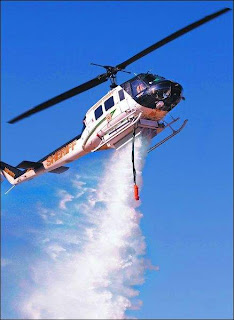The Yakima Herald-Republic has always taken the position that Ellreese Daniels and others should be punished severely for the errors in judgment that led to the deaths of the four firefighters on the Thirtymile fire in 2001. They are not pleased with the recent plea bargain in the case, according to their editorial published yesterday:
“In a New Year’s Eve editorial on the last day of 2006, we were willing to concede at the time that “four manslaughter charges brought against a U.S. Forest Service crew boss nearly 51/2 years after the deadly Thirtymile Fire in Okanogan County could finally be proof that justice delayed is not necessarily justice denied.”
That hope has been dashed now that a plea-bargaining deal has led to fire crew chief Ellreese Daniels pleading guilty in U.S. District Court in Spokane Tuesday to two misdemeanor charges of making false statements to investigators.
The magnitude of the reduction in charges is staggering: In exchange, the government dropped four felony counts of involuntary manslaughter and seven felony counts of making false statements.
Sentencing is set for
July 23August 18.“Like all plea agreements, there was a recognition of the evidence and the law as it exists,” Assistant U.S. Attorney Tom Rice said in an Associated Press report out of Spokane. “We feel this is an appropriate disposition of the case.”
Really? Will there ever be “appropriate disposition” of a case in which so many nagging doubts and unanswered questions remain? Four people died and the only person charged in the incident gets a plea-bargaining slap on the wrist and won’t have to face trial — during which a more complete story of what happened up to and during that fateful day could unfold during testimony.
Frankly, we’ve been less than impressed from the start with the federal government’s handling, at all levels, of the Thirtymile incident.
We also take note of the fact that Daniels was the only one to face criminal charges out of the fire near Winthrop that killed four Central Washington firefighters on July 10, 2001: Tom Craven of Ellensburg, and Karen FitzPatrick, Jessica Johnson and Devin Weaver, all from Yakima.
We remain convinced that Daniels must answer in part for the tragedy because he was directly responsible for the safety of his crew. But we also maintain that the blame for the Thirtymile debacle involves much more than just what happened on the fire line that day. Blame must also extend further up the chain of command and include a culture of stonewalling and cover-up so prevalent in the U.S. Forest Service at the time.
In addition, a September 2001 investigation by this newspaper revealed that the Forest Service broke more than a dozen of its own safety rules. Federal investigators came to an even more damning conclusion: The Forest Service had 28 rules in place to keep crews safe. At Thirtymile, 20 of them were broken, according to the U.S. Occupational Safety and Health Administration.
The negligence, according to the original charges, included Daniels failing to prepare the crew for the possibility of being overrun by flames.
The fact he was singled out prompts memories of the scandal at Abu Ghraib prison in Iraq when Iraqi prisoners were mistreated by United States military personnel. Of 10 people convicted out of that debacle, none ranked higher than staff sergeant. That in a system noted for its chain of command that demands the following of orders.
Reforms within the agency were supposed to ensure a tragedy such as Thirtymile never happened again. Yet, seven firefighters have been fatally trapped since by forest fires in Idaho and California.
That’s not to simply say the lessons of Thirtymile have not been heeded. After all, we’re talking about a very dangerous line of work, one in which every possible step must be taken to ensure the safety of firefighters on the line.
But we also don’t totally agree with the fears of many in the firefighting community that the unprecedented prosecution of Daniels might send a chilling message into the ranks of his colleagues across the nation — that they could face felony charges if something similar happened on their watches.
Anyone responsible for neglect of duty that leads to tragic consequences should face such charges. In our system of justice, whether such charges are justified is determined in a trial with all the pertinent facts on display, not with plea bargaining.
The plea deal may have technically closed the books on the prosecutorial phase of Thirtymile. But the nagging question remains: Will justice ever be completely, and adequately, served in this case?”



